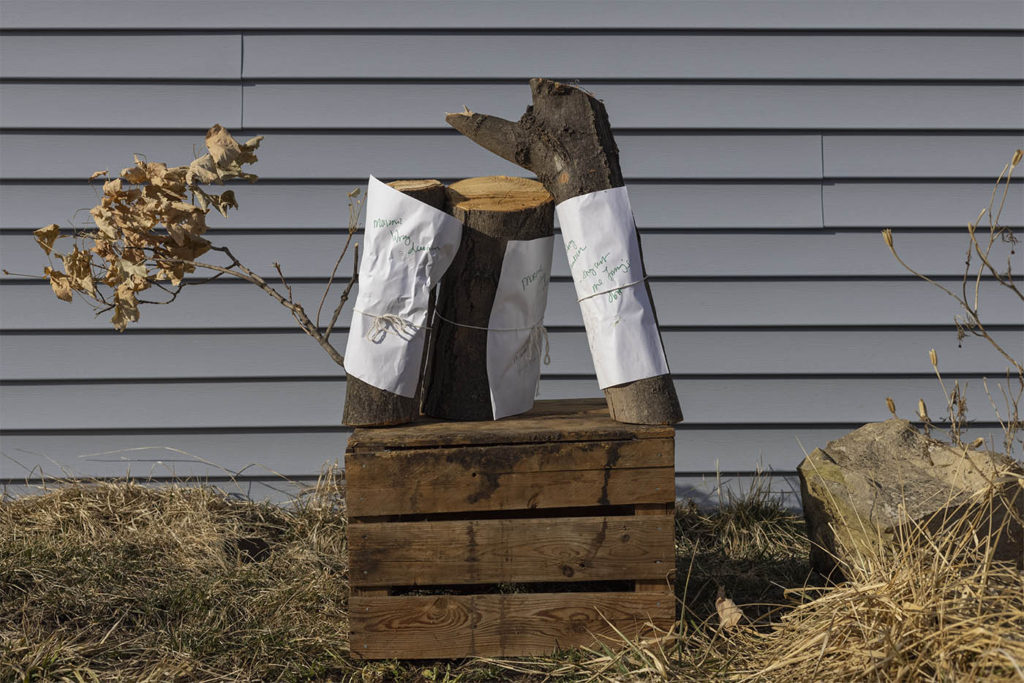
One of the most exciting parts of The Log Project is uncovering hidden histories while researching the locations where we picked up logs. Sometimes, we grabbed logs in locations with a personal connection and discovered a rich historical one, too. One such log: The Iowa Masonic Library & Museums.
For me, the personal connections are rich: My father was a Mason, for one. For another, many years after I moved away from Cedar Rapids, I was researching a mysterious, long-lost brother who died in 1983 after I met him only one time. I spent months attempting to find his obituary in newspaper databases, eager for proof he existed beyond a tattered, black & white portrait taken with my other two brothers sometime in the 60s (a decade before I was born). I searched every possible combination of words and names of surviving family to no avail. When I had almost given up hope, I came across a name that could’ve been him (by then I knew he died with a different last name) on a list of obituaries maintained by the Genealogical Society of Iowa … in the basement of the Masonic Library.
They mailed me a copy, and later, when I contacted newspaper databases with the date and missing paper date, it got scanned in for others to download.
It always felt a bit magical that this mysterious organization my father belonged to housed the archives that preserved the evidence of his secret son, my secret sibling.
So when I saw a log by the curb at the Masonic Library, I knew we had to grab it.
After drying it this past year and preparing to slice it, I started to think about how to represent this location in the codex. Surely, one page would feature Masonic symbolism, but what else?
In searching the library collection, I discovered it contains the papers of Dr. Arthur Erskine, a local physician & pioneer in radiology–so dedicated to the field he lost three fingers and endured over 30 surgeries & skin grafts due to exposure from his own experiments. For his sacrifice, his name is etched on the Monument to X-Ray and Radium Martyrs of All Nations in Hamburg, Germany.
He took leadership on adoption of the “r” standard for measuring radiation, wrote Practical X-Ray Treatment & numerous papers, founded radiology programs at Cedar Rapids hospitals, and pushed for physicians to listen to women, especially when it came to radical & life-altering treatments for gynecological cancers.
Erskine also advanced the idea of non-surgical treatment options for cancer, such as radiation, and for early detection to reduce the number of brutal surgeries as well as deaths. To this end, he initiated a study in 1948 to encourage women to get pap smears — and this is where our lives intersect: When I was 28, I benefited from early detection of cervical cancer. Unfortunately, my experience with detection and treatment still didn’t come with listening to me; I had a traumatic experience with a painful colposcopy & no anesthetic. So much of my disability activism has been focused on changing the way our medical model regards patients — and so here, I find a kindred spirit in Dr. Erskine.
So imagine my delight when I learned that Dr. Erskine was also a kindred spirit in art — a skilled & respected wood carver who sought out raw materials with meaningful provenances. In 1934, he even traveled to Epidaurus, birthplace of Hippocrates, to find native wood from which to carve gavels for the Linn County & Iowa State Medical Societies — a physical symbol (and reminder) of the Hippocratic Oath to punctuate every meeting. He was known to reclaim wood from the desks & microscope bases of fellow scientists as well.
The provenance of the wood mattered to him; it infused his gavels with meaning–material as message.
This, too, is how we see the logs for our project: each one infused with the magic and meaning of the place from which it comes. The provenance matters.
Were he alive today, I imagine Dr. Erskine carving gavels from derecho logs. Maybe he would even want to carve one from this log.
